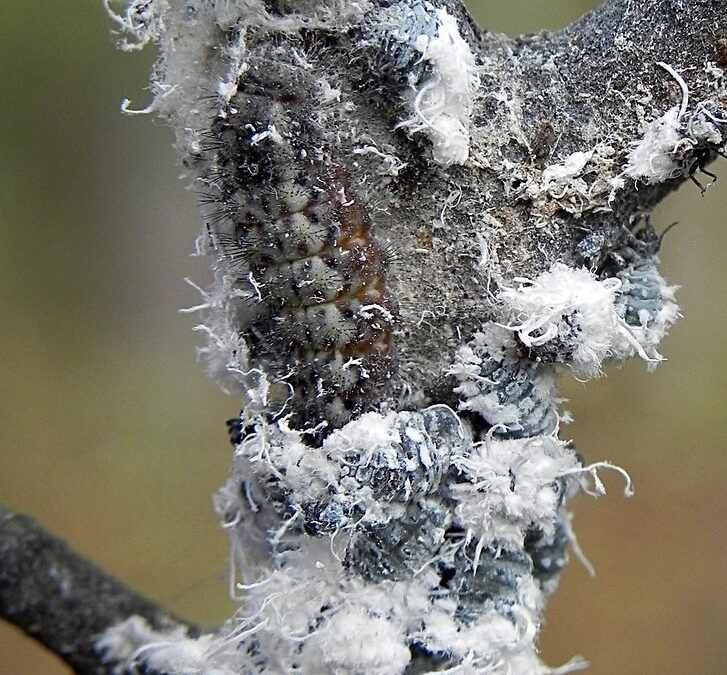By Katie Finch
This is the time of year we dress in costumes. We disguise ourselves as characters and take on different roles for the pleasure of being something or someone else. It’s a form of play. In the natural world, there are many animals that use disguise as a way to survive. Growing fur, feather, shells or skin to blend in or stand out is common in the animal world. There are some animals that don “costumes”, using parts outside of their bodies to survive too.
Recently, I was sitting outside working on a project. In clearing the table to make room for my materials, I was about to flick off a piece of fuzz when it moved. And not in the way a breeze blows a light object. It moved with the intention of something under its own power. I looked closer and under the fuzz I saw multiple legs, an elongated body, and some very large pinching mouthparts.
A quick search of the internet helped me give a name to the fuzz. It was a lacewing larva. This centimeter-long larva starts as an egg and will eventually grow and pupate into an cricket-like adult with delicate wings and long antenna. In the larval stage, they are voracious predators, eating almost any soft-bodied insect they can grab with their long pincers. The fact that they eat aphids and other garden pests make lacewing larva a desired and beneficial insect in gardens.
What attracted me most was the fuzz this larva was carrying on its back. It wasn’t part of the insect, but sat on top. I learned that some lacewing larva pile up small pieces of leaves, bark and other natural debris on their backs. After sucking out and eating the insides of their prey, they even attach the empty exoskeletons! This disguise helps them hide from predators and rightly earns them the nicknames of “Junk Bugs”.

Aphids are another insect that puts on a costume. Species of aphids, called wooly aphids, cover their bodies with a small, white strands that look like wool or cotton. One such aphid, the aptly named Wooly Alder Aphid, form patches of white fuzz on the trunks and branches of Speckled Alder trees. The aphids cling to the bark, using their piercing mouths to suck the sap from the tree. Ants are often seen moving among these aphids, tending these small insects much like humans tend cows to harvest their milk. Ants protect the aphids from predators and “milk” them for their high sugar content pee.
While the aphids “dress up” in wool, the real master of disguise among Wooly Alder Aphids is the Harvester caterpillar. Unlike most other caterpillars who eat leaves, the Harvester is carnivorous. It feeds on Wooly Alder Aphids. How does a caterpillar sneak by the attentive and sharp-mouthed ants? In a disguise of course! As it grows, it covers its soft body in the white, waxy skins of the aphids it has eaten. It is certainly a wolf in sheep’s clothing.
Just like the last-minute scramble to find a Halloween costume, some disguises are built with what is available. Caddisflies are a group of insects, who spend the larval part of their life under the water of ponds, creeks, lakes, or wetlands. The larva is no more that a few centimeters long and easy prey for larger insects or fish. To protect and camouflage themselves, many species build a portable, tube-like case using materials from their surroundings and silk from their mouth.
Dip a net into the water and you may pull up these cases with the caterpillar-looking larva inside. Cases may be made of sand, pebbles, leaves, sticks, or stems. Some look messy and unplanned. Others look meticulously engineered, such as the Snailcase Maker Caddisfly, who’s case looks like the shell of a snail.

This construction of a portable home by materials available served as inspiration for French artist, Herbert Duprat. In the 1980s, he collected caddisfly larva, removed their protective cases and placed them in an aquarium, not with their native leaves, sticks, and stems but with gold flakes, pearls, sapphires, rubies, and other small, precious stones. The larva made cases just the same, with silk and the materials around them.
I recently told a group of kids about the lacewing larva. They immediately compared it to the Decorator Crab, which lives in ocean habitats. This crab also decorates itself with natural materials found in its environment as way of protection from predators. The natural world is full of strange and interesting ways animals and plants survive. But I shared these few examples of masters of disguise because we can find them in our local adventures where we live. And nature is a wonderful teacher when you get outside and explore.
Katie Finch is an educator at Audubon.
Audubon Community Nature Center builds and nurtures connections between people and nature. ACNC is located just east of Route 62 between Warren and Jamestown. The trails are open from dawn to dusk and birds of prey can be viewed anytime the trails are open. The Nature Center is open from 10 a.m. until 4:30 p.m. daily except Sunday when it opens at 1 p.m. More information can be found online at auduboncnc.org or by calling (716) 569-2345.


Recent Comments